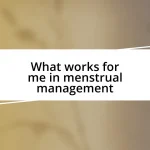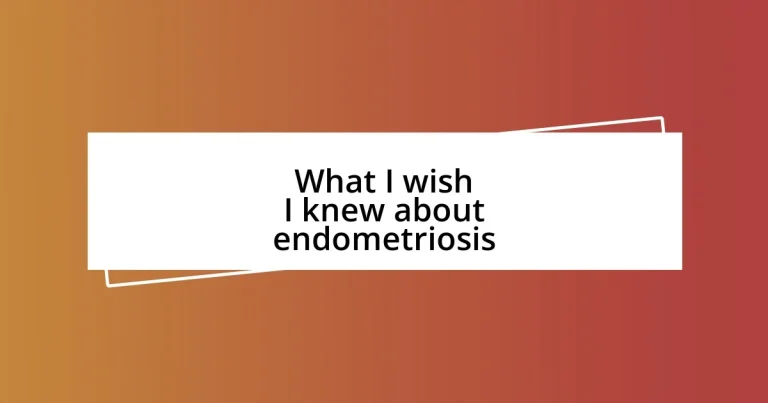Key takeaways:
- Understanding endometriosis symptoms is crucial; tracking symptoms can empower patients to better communicate with healthcare providers.
- Diagnosis may require advocacy and persistence, as symptoms overlap with other conditions and multiple diagnostic methods exist.
- Support networks offer emotional relief and practical resources, helping individuals cope with the long-term physical and emotional effects of endometriosis.
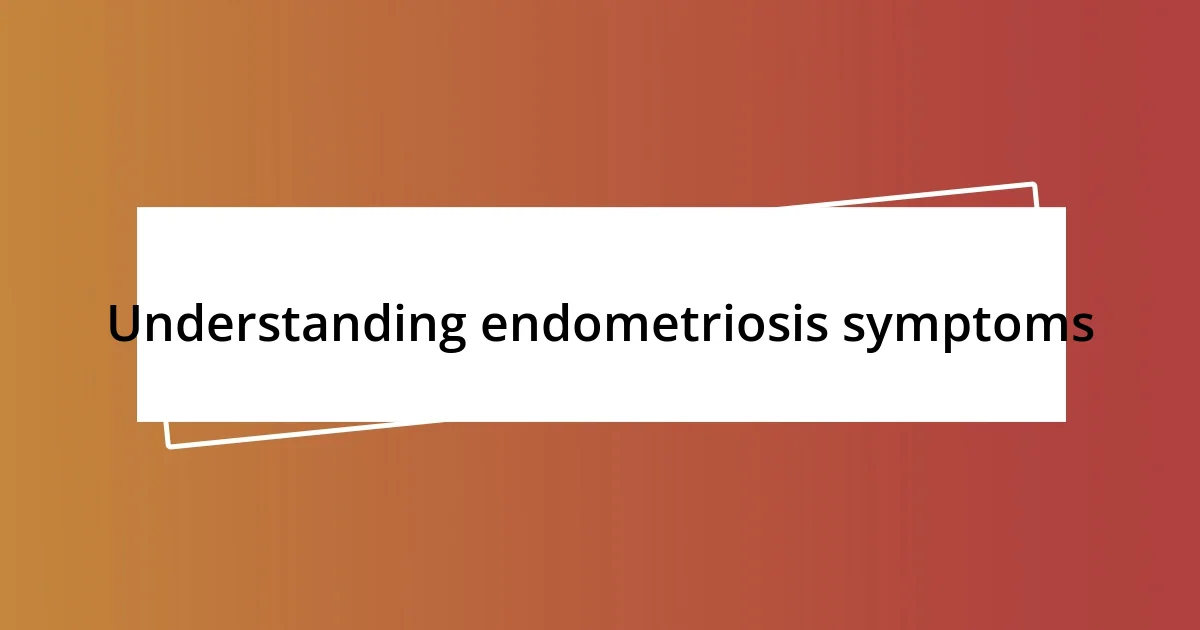
Understanding endometriosis symptoms
Understanding the symptoms of endometriosis can be quite challenging, and it often feels like navigating a maze. I remember the first time I experienced those intense pelvic pains; I thought it was just another harsh period cramp. However, when the pain lingered long after my period ended, I began to wonder if something deeper was going on.
Many women also report symptoms like painful intercourse, heavy menstrual bleeding, and fatigue. It’s not just physical discomfort; the emotional toll can be overwhelming. I found myself grappling with anxiety, feeling isolated, and questioning my body. Have you ever been in such a situation where your body just doesn’t feel right, yet you can’t put your finger on why?
In my experience, tracking symptoms became essential in understanding my condition. I started keeping a journal to note not just the physical symptoms, but also how they affected my daily life and mood. This simple act turned from a frustrating chore into an empowering tool. It made me more connected to my body and helped me communicate clearly with my doctor about what I was experiencing. How has tracking your symptoms helped you in your journey?
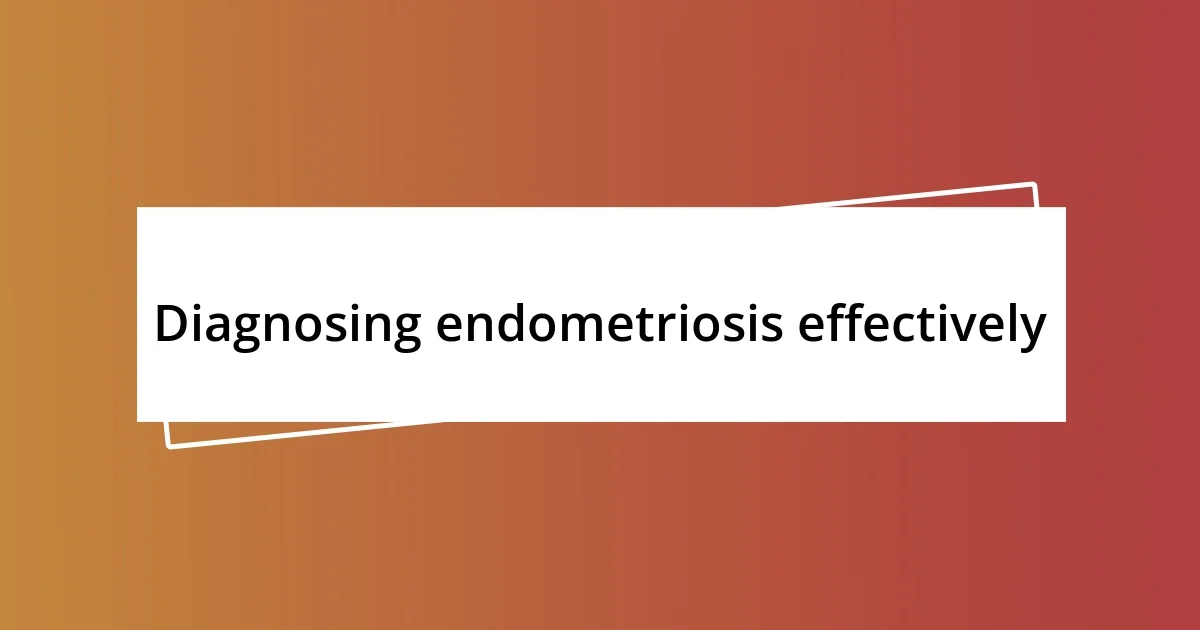
Diagnosing endometriosis effectively
Diagnosing endometriosis can often feel like piecing together a puzzle, due to its symptoms overlapping with other conditions. I recall my frustration when several doctors dismissed my pain as typical menstrual discomfort. Eventually, a gynecologist listened to my concerns and suggested further testing, which finally led to a definitive diagnosis. It reminds me how important it is to advocate for ourselves; sometimes, our experiences need louder voices.
The process itself can vary greatly depending on the healthcare provider’s knowledge and approach. For example, while some specialists may rely heavily on imaging techniques like ultrasounds to identify cysts, others might recommend a laparoscopy for a more definitive diagnosis. I personally found that open communication with my doctors was vital—they guided me through each step, making a daunting process feel manageable.
While there is no single test for endometriosis, a combination of methods can yield effective results. I learned that understanding the differences and knowing what to expect helps in managing anxiety throughout the diagnostic journey. Here’s a quick comparison of some common diagnostic approaches:
| Diagnostic Method | Description |
|---|---|
| Pelvic Exam | A doctor checks for abnormalities manually but it can be limited in accuracy. |
| Ultrasound | Uses sound waves to create images of the organs; helpful in identifying cysts. |
| Laparoscopy | A surgical procedure allowing direct visualization of the pelvic organs; considered the gold standard. |
It’s crucial that women are proactive in discussing their symptoms and possible diagnostic avenues. Have you ever encountered a moment where explaining your symptoms to a doctor made all the difference?
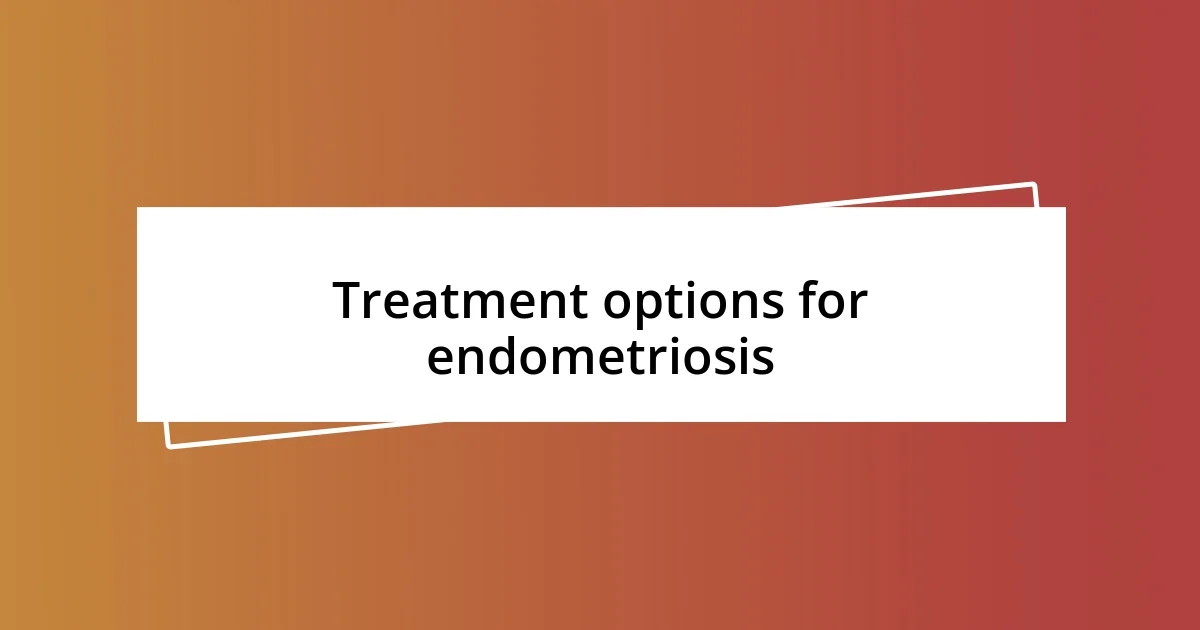
Treatment options for endometriosis
When it comes to treating endometriosis, the options can be quite varied and often depend on the severity of the condition and individual symptoms. I remember feeling overwhelmed by the choices available when I was finally ready to seek treatment. It felt like a whirlwind of information, but understanding these options made the journey manageable.
Here are some common treatment options for endometriosis:
- Pain Relief Medications: Over-the-counter pain relievers like ibuprofen can help alleviate pain during menstruation.
- Hormonal Therapy: This approach works by regulating hormones to reduce or eliminate periods, which can lessen the growth of endometrial tissue.
- Laparoscopic Surgery: In cases of severe endometriosis, surgery can be necessary to remove the endometrial tissue or even cysts that develop, leading to significant pain reduction.
- Lifestyle Changes: Incorporating dietary modifications, regular exercise, and stress management techniques can help enhance overall well-being.
- Fertility Treatment: For those facing challenges with conception, fertility treatments such as IVF may be considered when endometriosis is in play.
It’s essential for women to work closely with their healthcare provider to find a treatment plan that feels right. I vividly recall my discussions with my doctor, which included not just the physical aspects of treatment, but also how I’d feel emotionally and mentally. I was relieved to discover that there isn’t a one-size-fits-all solution—what works for one person might not work for another. Listening to my body and reflecting on my experiences empowered me to play an active role in my treatment journey. Have you found that communicating your preferences and experiences with your physician has shaped your treatment path?
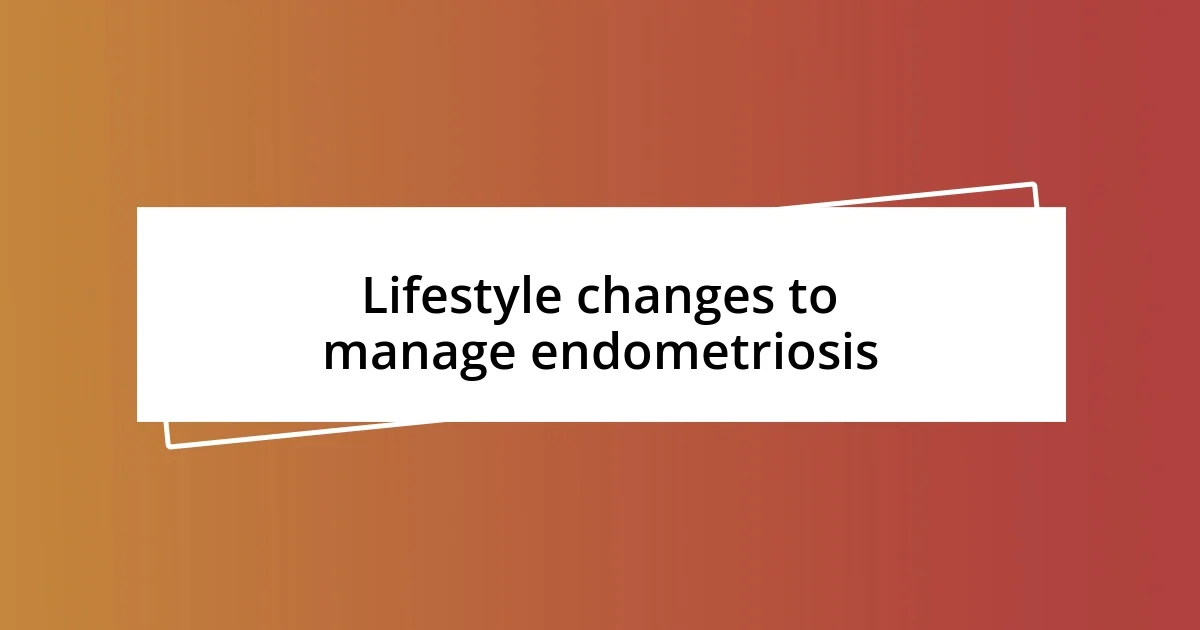
Lifestyle changes to manage endometriosis
When managing endometriosis, incorporating dietary changes can be highly beneficial. I’ve discovered that certain foods can trigger inflammation and exacerbate symptoms, so I started paying closer attention to my diet. For instance, I noticed a significant difference when I reduced my intake of processed foods and increased my consumption of leafy greens and omega-3 fatty acids. Have you ever considered how what you eat may be influencing your body?
Regular physical activity has also been a game changer for me. While the fatigue and pain can sometimes make it hard to get moving, I found that gentle exercises like yoga and walking help ease my symptoms. It’s fascinating to think about how movement can stimulate circulation and promote the release of endorphins, which can significantly uplift my mood. Have you found a workout routine that resonates with you?
Stress management is yet another crucial aspect in navigating this condition. I remember feeling overwhelmed by my symptoms, which only intensified my stress. Discovering mindfulness techniques, like meditation and deep breathing exercises, has provided me with a sense of control. These practices allow me to reconnect with my body and mind, especially during flare-ups. What strategies have you discovered to calm your mind amidst the chaos of endometriosis?
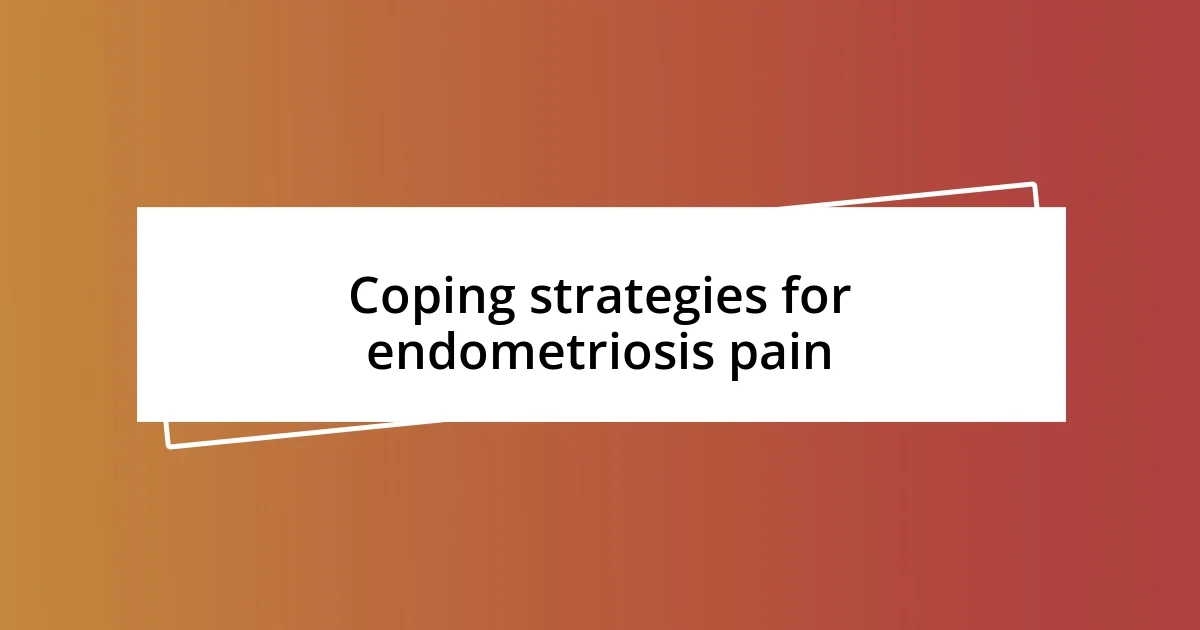
Coping strategies for endometriosis pain
When I began exploring coping strategies for endometriosis pain, I quickly realized the power of heat therapy. Applying a heating pad to my abdomen not only provided immediate relief but also helped ease my tension and discomfort during especially painful nights. Have you ever had that moment where warmth just envelops you in comfort? It’s incredible how something so simple can make a world of difference.
I also learned that staying connected with a supportive community played a significant role in my coping journey. I remember joining an endometriosis support group, and sharing stories not only validated my feelings but also opened my eyes to different coping techniques. It’s hard to express the relief I felt, knowing I wasn’t alone in this struggle. Have you considered tapping into the strength of shared experiences?
Lastly, I can’t overstate the value of listening to my body. I found that keeping a pain diary—tracking my symptoms, triggers, and coping methods—helped me identify patterns. This practice not only empowered me to connect the dots, but it also provided a helpful conversation starter with my healthcare provider. Have you tried documenting your experiences? It can be enlightening to see how your body responds to different treatments and coping strategies.
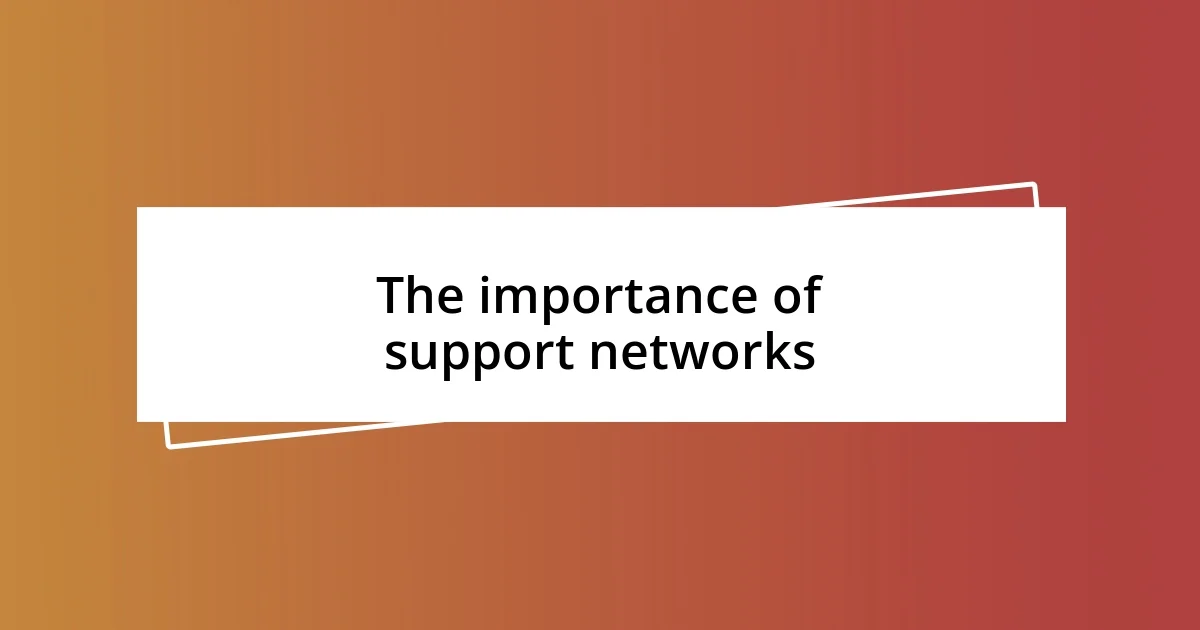
The importance of support networks
Support networks are not just a luxury; they are essential for navigating the complexities of endometriosis. When I first learned about my diagnosis, I was overwhelmed, but connecting with others who understood my pain made all the difference. Have you ever found solace in someone else’s story? Sharing experiences can validate our feelings and help us feel less isolated in our battles.
As I attended meetups and online forums, I discovered how valuable it is to hear different perspectives on coping strategies. One time, a member shared how journaling her pain experiences not only helped her process emotions but also allowed her to share these insights with her doctor. I remember thinking, “Wow, I hadn’t considered how sharing could open new doors to understanding!” Have you explored ways a support network could enrich your journey?
Beyond emotional relief, support networks can provide practical resources. I’ve gained access to helpful information, from dietary tips to the latest research on endometriosis treatments. Connecting with others means pooling knowledge—something I wish I had discovered sooner. Don’t you think there’s power in numbers? When we come together, we become stronger advocates for ourselves and others.
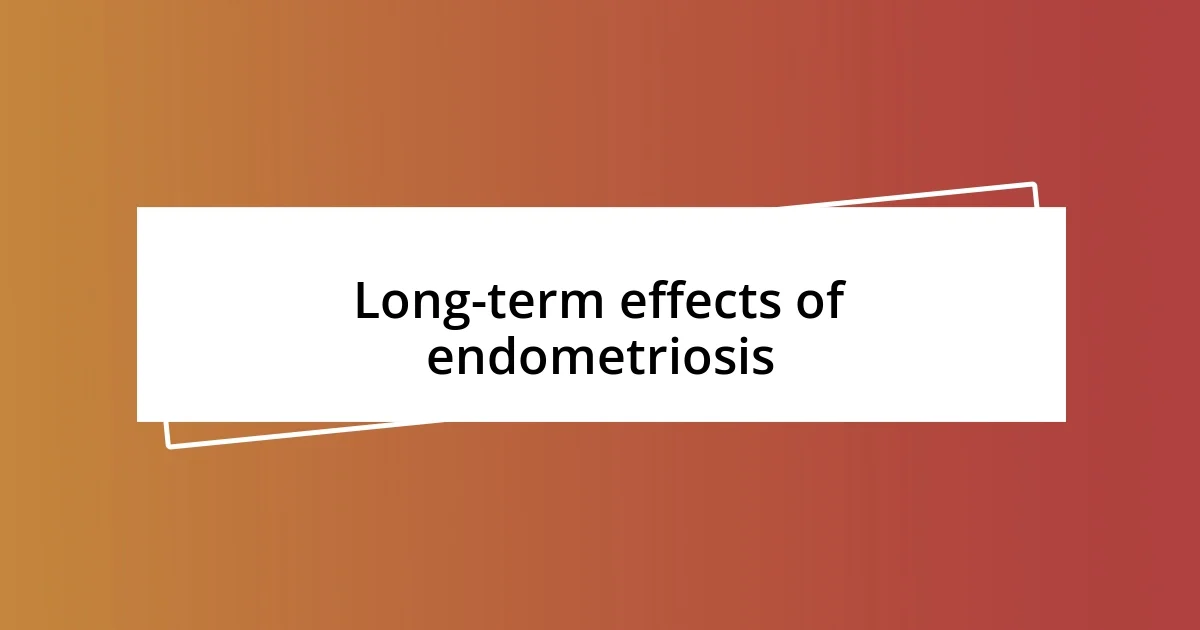
Long-term effects of endometriosis
The long-term effects of endometriosis can ripple through many facets of life, affecting not just physical health but also emotional well-being. I once spoke with someone who described how years of battling endometriosis had taken a toll on her mental health, leading to anxiety and depression. Have you ever felt like the emotional strain of a chronic condition is just as heavy as the physical pain? It’s mind-boggling how intertwined our minds and bodies can be.
As I navigated my own journey, I noticed that the unpredictability of symptoms sometimes hindered my career aspirations. After all, it’s hard to focus on long-term goals when your body is frequently reminding you of its battles. I remember a day when I had to cancel a crucial meeting due to pain—I felt a rush of frustration and guilt. It wasn’t just about the impact on my work but also how it reinforced feelings of inadequacy. Can you relate to that pressure of wanting to ‘keep up’ despite ongoing struggles?
Moreover, the potential for fertility issues loomed over my thoughts as I considered my future. I recall sitting in a doctor’s office, hearing about the possible complications and feeling an unsettling mix of fear and uncertainty. The reality is that endometriosis can lead to challenges in conception for many, which adds another layer to an already complicated emotional landscape. Have you pondered how such potential outcomes shape the decisions you make about your future? It’s a heavy door to look through, isn’t it?
